Liquid Crystal EO Amplitude Modulators, Free Space

- Liquid Crystal EO Modulator / Variable Attenuator
- Attenuation Control Using SMA Modulation Input or Potentiometer
- Models with Wavelength Ranges Covering 425 - 1620 nm Available
Front
Modulation
Input
Back
Application Idea
NEL02A EO Modulator
with Half-Wave Plate in
CRM1T Rotation Mount
NEL01A

Please Wait
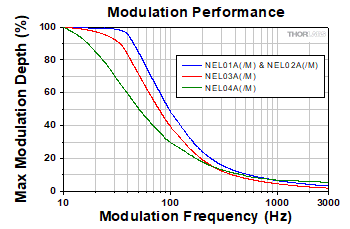
Click to Enlarge
Modulation Performance of Thorlabs' LC EO Modulators/Noise Eaters
Features
- Modulate the Intensity of Signals Using an Internal Liquid Crystal Variable Waveplate
- Low, 0 - 2.5 V Modulation Input Voltage Range
- Ø4 mm Clear Aperture
- SMA Modulation Input Connector
- Also Functions as a Noise Eater or Variable Attenuator
- Models for use at 425 - 650 nm, 475 - 650 nm, 650 - 1050 nm, or 1050 - 1620 nm
- Maximum Input Power of up to 1.65 W, Depending on Model, Wavelength, and Beam Size
(See the Operation Tab for Details)
Thorlabs' Noise Eaters are liquid crystal (LC) devices that can function as electro-optic (EO) modulators. They use a liquid crystal retarder and a polarizer with a closed-loop feedback system to precisely and quickly attenuate light with no moving parts. The attenuation can be controlled using the SMA modulation input or an onboard potentiometer. Additionally, the noise eaters' attenuation can be controlled automatically by the feedback loop, allowing them to function as a noise reduction device. These noise eaters/EO modulators are designed for use with light in the 425 - 650 nm [Item # NEL01A(/M)], 475 - 650 nm [Item # NEL02A(/M)], 650 - 1050 nm [Item # NEL03A(/M)], or 1050 - 1620 nm [Item # NEL04A(/M)] wavelength range. We offer noise eater models for low (<60 mW) or high (<1.65 W) power use; see the Specs tab for details.
Power Attenuation and Modulation
These noise eaters are also capable of continuously attenuating and modulating the laser output using the liquid crystal retarder and integrated polarizer. Unlike most attenuators available, Noise Eaters attenuate the laser power rapidly without the use of any mechanical components. The noise eater's attenuation capabilities can be controlled via the onboard potentiometer or electrical modulation input.
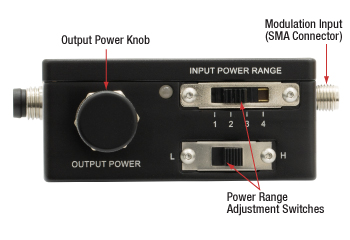
Click for Details
NEL02A Top View Showing Power Range Adjustment Switches and Modulation Input
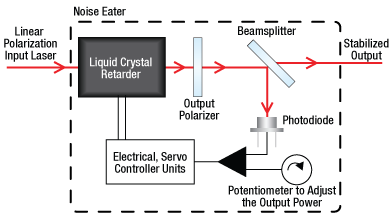
Click to Enlarge
Noise Eater Block Diagram
Noise Reduction
Utilizing a liquid crystal amplitude modulator, combined with an internal photodiode for power measurement and a feedback control circuit, these noise eaters can eliminate intensity noise in linearly polarized light, achieving amplitude stabilization of within 0.05% of a selected output power. The input power can be set to one of several ranges using the switches on the top of the unit, which permit the noise eater to remove noise without unnecessarily attenuating the signal power. The potentiometer is then adjusted to select the output power (see the Operation tab for more information). Long-term performance and frequency characterization for each noise eater model are shown on the Performance tab.
Mechanical Compatibility
Thorlabs' Noise Eaters are post mountable in two orientations via 8-32 (M4) tapped holes. They also feature 4-40 tapped holes on the front and back for 30 mm Cage System compatibility and an SM1-threaded (1.035"-40) rear aperture for Ø1" Lens Tube compatibility.
| Item # | NEL01A(/M) | NEL02A(/M) | NEL03A(/M) | NEL04A(/M) | |
|---|---|---|---|---|---|
| Wavelength Range | 425 - 650 nm | 475 - 650 nm | 650 - 1050 nm | 1050 - 1620 nm | |
| Switchable High Power Mode | - | ||||
| Noise Attenuation Performance Specs | |||||
| Output Power Stabilitya | ±0.05% (RMS) | ||||
| Noise Attenuation Frequency Rangeb | DC - 1.8 kHz | DC - 2.5 kHz | DC - 1.4 kHz | ||
| Noise Attenuation Amplitude Range | 0.1% to 50% of Input Signal | ||||
| Noise Attenuation Factorc | >150 at 10 Hz, 80 at 60 Hz 20 at 400 Hz, 4 at 1 kHz |
>150 at 10 Hz, 80 at 60 Hz 10 at 400 Hz, 1.5 at 1 kHz |
|||
| Effective Output Power Attenuation Ranged | 1 - 40 | 1 - 5 | |||
| Internal Polarizer Blocking DamageThreshold (Maximum Power Attenuation) |
1 W/cm2 | 10 W/cm2 | |||
| Attenuation Control | Onboard Potentiometer (10 Turns) or SMA Modulation Input | ||||
| Optical Specs | |||||
| Transmission (Click for Plot) | >85% at 635 nm | >80% at 635 nm | >85% at 780 nm | >85% at 1550 nm | |
| Power Level Switching | Four Position Power Range Switch | High/Low Power Mode Switch and Four Position Power Range Switch | |||
| Maximum Input Power | See the Max Powers at Various Wavelengths Section on the Operation Tab | ||||
| Minimum Input Power | 0.5 mW | ||||
| Polarization Extinction Ratio at Output | >1000:1 Over Wavelength Range | ||||
| Damage Threshold (CW)e | 0.8 W/cm2 | 8 W/cm2 | |||
| Input Aperture | Ø5 mm | ||||
| Input Beam Diameterf | Ø4 mm (Max) | ||||
| Output Beam Displacement | 1 mm Vertically (in the Direction of Input Polarization) | ||||
| Beam Divergence | 5 mrad (Max) | ||||
| Angle of Incidence | ±2° (Max) | ||||
| Input Polarization Tolerance | ±3° | ||||
| Wavefront Distortion | ≤λ/4 at 635 nm | ≤λ/2 at 635 nm | |||
| AR Coating | Ravg <0.5% from 400 - 650 nm | Ravg <0.5% from 650 - 1100 nm | Ravg <0.5% from 1050 - 1620 nm | ||
| Modulation Performance Specs | |||||
| Modulation Input | SMA Connector, 0 - 2.5 V, 10 kΩ Input Impedance | ||||
| Extinction Ratiog | 512.6 | 7.7 | 6.5 | ||
| Minimum Rise / Fall Timeh | 0.65 ms / 7.3 ms | 0.75 ms / 11.5 ms | 2.8 ms / 25 ms | ||
| Pulsed Laser Input Repetition Rate | >1 MHz | ||||
| General Specs | |||||
| Mounting Options | Two 8-32 (M4) Tapped Holes for Post Mounting 30 mm Cage System Compatible via Eight 4-40 Tapped Holes Ø1" Lens Tube Compatible via 4 mm Deep Internal SM1 Threads on Rear Side |
||||
| Operating Temperature Range | 15 °C to 45 °C | ||||
Noise Eater Performance Graphs
In the graphs below, noise attenuation was measured as one of three parameters was varied: input power level, input signal modulation (noise) amplitude, and output signal attenuation. The graphs show that the noise eaters provide consistent performance regardless of changes in these parameters.
Graph Definitions
Modulation Performance
In these graphs, a sine wave with a 2.5 V amplitude and an increasing frequency was used to modulate a noiseless input beam. The graphs show that the maximum modulation depth decreases with increasing modulation frequency. Further testing has demonstrated that the modulation performance is consistent for a given noise eater model, regardless of the laser beam's input power.
Noise Attenuation at Various Input Power Levels
Noise attenuation factor is the ratio of noise amplitude before and after the noise eater. In these graphs, the attenuation factor was measured for several different input power levels, with a fixed signal modulation depth (noise amplitude). The graphs below show that the noise eaters provide consistent performance regardless of input power level.
Noise Attenuation at Various Input Signal Modulations
In these graphs, the input signal was modulated with a sine wave to simulate noise. The attenuation factor was measured at a variety of modulation depths (noise amplitudes). The graphs below show that the noise eater provides consistent performance even at large noise levels.
Noise Attenuation at Various Output Signal Power Levels
Since the noise eater uses a liquid crystal modulator as the optical control element, the noise attenuation is achieved by attenuating the laser beam when noise appears. Our noise eaters are carefully designed to optimize the noise attenuation performance without needing to severely attenuate the signal. These graphs demonstrate that the specified noise attenuation can be reached with a cost of only 5% - 10% overall attenuation of the output power, and further increases in attenuation does not significantly improve the noise attenuation.
NEL01A(/M): Low Power Noise Eater for Visible (425 - 650 nm)
Click here to download raw data.
NEL02A(/M): High/Low Power Noise Eater for Visible (475 - 650 nm)
Click here to download raw data.
NEL03A(/M): High/Low Power Noise Eater for NIR (650 - 1050 nm)
Click here to download raw data.
NEL04A(/M): High/Low Power Noise Eater for IR (1050 - 1620 nm)
Click here to download raw data.
Operation
Thorlabs' Liquid Crystal EO Modulators/Noise Eaters are precision instruments for modulating, stabilizing, and attenuating laser power. The modulator consists of a variable attenuator (liquid crystal wave plate and polarizer), a calibrated beamsplitter, and a servo controller to control the modulator, as depicted in the block diagram to the right.
Linearly polarized light is input into the liquid crystal retarder, which, together with the output polarizer, acts as a variable retarder. A beamsplitter then sends a small part of the beam to a feedback loop consisting of a photodiode and control servo. The servo compares the optical signal to a preset signal level and applies the appropriate adjustment voltage until the optical signal reaches the desired level.
The noise eater can also be used as a variable attenuator, even without the presence of noise. By adjusting the resistance of the potentiometer, the user can set the desired output power level.
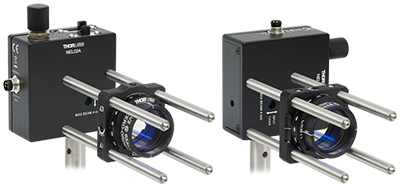
Click to Enlarge
The Noise Eater can be post mounted in two different orientations to match the input light's direction of polarization. A CRM1T(/M) Cage Rotation Mount and four 30 mm Cage Rods can mount a half-wave plate for fine tuning the polarization alignment.
Mounting and Alignment
The noise eater is designed to work with linearly polarized input light aligned with the direction of the arrow engraved on the noise eater near the input aperture. Linearly polarized light and proper alignment of the direction of polarization are important for achieving the best results from the noise eater.
In order to minimize optical losses, the noise eater does not have an input polarizer. If the incident light is not linearly polarized, a linear polarizer must be placed before the noise eater to polarize the incident light.
If the incident light is linearly polarized but is not aligned exactly vertically or horizontally, a half-wave plate can be used before the noise eater to rotate the polarization axis. As shown in the photo to the right, the noise eater's cage mount can be used along with a CRM1T(/M) cage rotation mount to rotate the half-wave plate, thus aligning the polarization axis with the noise eater.
For post mounting, the noise eater is equipped with two 8-32 (M4) threaded holes. These holes are offset by 90° so that light with a vertical or horizontal polarization axis can be aligned with the noise eater. The four 4-40 holes on the front of the noise eater can also be used to mount the noise eater in either a horizontal or vertical orientation using the Thorlabs 30 mm Cage System.
For best performance of the noise eater, it is recommended that the beam be well centered within the input aperture. Due to the optical path inside the noise eater, the output beam will be shifted down by 1.0 mm if the noise eater is mounted vertically, as shown in the left view in the figure to the right. Similarly, the output beam will be shifted sideways by 1.0 mm if the noise eater is mounted horizontally, as shown in the right view in the figure to the right.

Click to Enlarge
In the data plotted above, a sine wave with a 2.5 V amplitude and an increasing frequency was used to modulate a noiseless input beam.
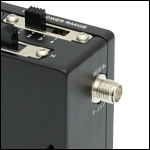
Click to Enlarge
SMA Modulation Input Jack
Modulation
There is an SMA interface at the right side of the noise eater, which can be used to modulate the attenuation of the noise eater. The modulation input has a 10 kΩ input impedance. A voltage ranging from 0 to 2.5 V can be input to modulate the output power from 0 to full output. Before modulating the output power, first turn the output power level knob clockwise to the end of its travel (minimum output power setting).
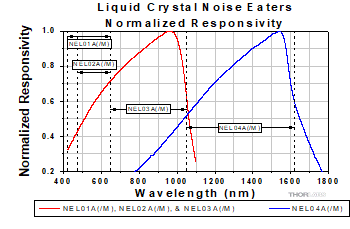
Click to Enlarge
The dotted lines represent operating wavelength regions for each of the noise eaters.

Click to Enlarge
Top View Showing Power Range Adjustment Switches
Power Range Adjustment
The selection switch(es) at the top of the noise eater are used to select the input power range. The power selector should be set to the lowest value that is still higher than the actual power of the laser. For example, if the NEL01A(/M) is being used with a beam power of 8 mW at 635 nm, the selector should be set to position 3, which represents 10 mW. For specifications, refer to the Max Power tables below.
The NEL02A(/M), NEL03A(/M), and NEL04A(/M) noise eaters have two selection switches at the top of the case, which are used to select the input power range. When the low/high power switch is set to "LOW", the input power range can be set to one of the lower set of powers; when the status switch set to "HIGH", the input power range can be set to one of the higher set of powers. For specifics, refer to the Max Power tables below. Note that the NEL01A noise eater has only one selection switch.
The NEL01A(/M), NEL02A(/M), and NEL03A(/M) noise eaters use a silicon detector as part of the feedback loop, while the NEL04A noise eater uses a germanium detector. The responsivity of the detectors is different for different wavelengths, and so the power settings on the selector only correspond to the design wavelength of the detector [635 nm for Item #s NEL01A(/M) and NEL02A(/M), 780 nm for Item # NEL03A(/M), 1550 nm for Item # NEL04A(/M)]. The power range at a given wavelength is inversely proportional to the responsivity (a higher responsivity value will result in a lower power range value). The graph to the right shows the relative responsivity of both detectors at a range of wavelengths. The tables below show a rough estimate of the power settings at various wavelengths for each model.
The noise eater operates by varying how much of the signal is attenuated in order to reach the target output power and attenuate the noise. Since the noise eater can attenuate the signal but not amplify it, the clean output beam can only have a power as high as the minimum power level of the noisy signal. In practice, to remove all noise without unnecessarily attenuating the signal power, the output power level should be set to slightly lower than the minimum power of the noisy signal. See the manual for more information.
Max Powers at Various Wavelengths
The tables below list the maximum input powers for each noise eater, specified for a variety of input wavelengths and switch settings. Please note that these maximum power levels correspond to the feedback electronics of the noise eater, and in some cases, the actual maximum input power is instead limited by the damage threshold of the noise eater. For the high power noise eaters [Item #s NEL02A(/M), NEL03A(/M), and NEL04A(/M)], this damage threshold is 8 W/cm2, which corresponds to a maximum input power of 1 W if the input power is distributed evenly across the Ø4 mm clear aperture. For the low power NEL01A(/M) noise eater, the damage threshold is 0.8 W/cm2, which corresponds to a maximum input power of 100 mW if the input power is again distributed evenly across the Ø4 mm clear aperture.
| NEL01A(/M) Max Power at Various Wavelengths | |||
|---|---|---|---|
| Switch Position |
Max Power at 450 nm |
Max Power at 550 nm |
Max Power at 635 nm |
| 1 mW | 2 mW | 1.5 mW | 1 mW |
| 3 mW | 6 mW | 4.5 mW | 3 mW |
| 10 mW | 20 mW | 15 mW | 10 mW |
| 30 mW | 60 mW | 45 mW | 30 mW |
| NEL02A(/M) Max Power at Various Wavelengths | ||||
|---|---|---|---|---|
| Switch Position |
Max Power at 450 nm |
Max Power at 550 nm |
Max Power at 635 nm |
|
| L | 1 | 2 mW | 1.5 mW | 1 mW |
| L | 2 | 6 mW | 4.5 mW | 3 mW |
| L | 3 | 20 mW | 15 mW | 10 mW |
| L | 4 | 60 mW | 45 mW | 30 mW |
| H | 1 | 200 mW | 150 mW | 100 mW |
| H | 2 | 600 mWa | 450 mW | 300 mW |
| H | 3 | 1000 mWa | 750 mWa | 500 mW |
| H | 4 | N/Ab | ||
| NEL03A(/M) Max Power at Various Wavelengths | |||||||
|---|---|---|---|---|---|---|---|
| Switch Position |
Max Power at 650 nm |
Max Power at 700 nm |
Max Power at 780 nm |
Max Power at 900 nm |
Max Power at 1000 nm |
Max Power at 1100 nm |
|
| L | 1 | 1.2 mW | 1.1 mW | 1 mW | 0.9 mW | 0.9 mW | 3.3 mW |
| L | 2 | 3.5 mW | 3.3 mW | 3 mW | 2.6 mW | 2.7 mW | 10.0 mW |
| L | 3 | 11.8 mW | 11.1 mW | 10 mW | 8.8 mW | 8.9 mW | 33.3 mW |
| L | 4 | 35.5 mW | 33.3 mW | 30 mW | 26.3 mW | 26.8 mW | 100 mW |
| H | 1 | 120 mW | 111 mW | 100 mW | 86.0 mW | 89.3 mW | 333 mW |
| H | 2 | 355.5 mW | 333 mW | 300 mW | 258.0 mW | 268 mW | 999 mWa |
| H | 3 | 600 mWa | 500 mW | 500 mW | 430.0 mW | 446.6 mW | 1650 mWa |
| H | 4 | N/Ab | |||||
| NEL04A(/M) Max Power at Various Wavelengths | ||||||||
|---|---|---|---|---|---|---|---|---|
| Switch Position |
Max Power at 1050 nm |
Max Power at 1150 nm |
Max Power at 1250 nm |
Max Power at 1350 nm |
Max Power at 1450 nm |
Max Power at 1550 nm |
Max Power at 1620 nm |
|
| L | 1 | 1.9 mW | 1.6 mW | 1.4 mW | 1.2 mW | 1 mW | 1 mW | 1.6 mW |
| L | 2 | 5.8 mW | 4.8 mW | 4.1 mW | 3.5 mW | 3.1 mW | 3 mW | 4.8 mW |
| L | 3 | 19.2 mW | 16 mW | 13.7 mW | 11.7 mW | 10.4 mW | 10 mW | 16 mW |
| L | 4 | 57.6 mW | 48 mW | 41.1 mW | 35.1 mW | 31.3 mW | 30 mW | 48 mW |
| H | 1 | 190 mW | 160 mW | 137 mW | 117 mW | 104.7 mW | 100 mW | 160 mW |
| H | 2 | 500 mW | 480 mW | 411 mW | 351 mW | 313.4 mW | 300 mW | 480 mW |
| H | 3 | 835 mWa | 800 mWa | 685 mWa | 585 mWa | 520 mWa | 500 mW | 800 mWa |
| H | 4 | N/Ab | ||||||
| Posted Comments: | |
| No Comments Posted |

- NEL01A(/M) is a Low-Power Noise Eater (0.5 mW to 60 mW) with a Modulation Input and 425 - 650 nm Wavelength Range
- NEL02A(/M) is a Switchable Low/High-Power Noise Eater (0.5 mW to 1000 mW) with a Modulation Input and 475 - 650 nm Wavelength Range
 Products Home
Products Home









 Liquid Crystal EO Modulators
Liquid Crystal EO Modulators